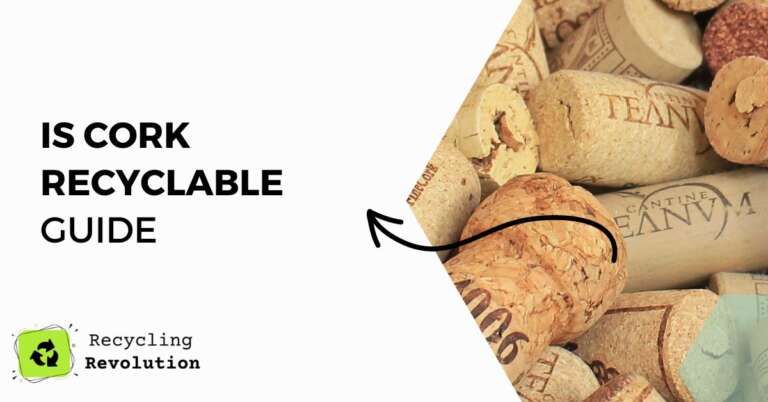Cork, a material synonymous with wine stoppers, pinboards, and flooring, is not just remarkable for its versatility, but also for its environmentally-friendly attributes. Derived from the bark of the cork oak tree, its recyclability sets it apart from many other materials, aligning it more with a circular economy model that prioritizes sustainability.
TL;DR: Cork is indeed recyclable, and this quality, alongside its natural renewal capacity, make it an exemplary choice for those committed to sustainability. The recycling process can transform old cork products into new, diverting waste from landfills and lowering our carbon footprint.
Cork’s Economic and Social Impact
The cork industry holds an important place in the global economy, particularly in countries like Portugal and Spain, where the majority of the world’s cork is harvested. It provides employment for many local communities, playing a significant role in their economic well-being.
Moreover, as the demand for sustainable products grows, so does the potential for cork. Initiatives focusing on the collection and recycling of used cork products can generate additional employment opportunities, fostering economic growth and promoting social inclusion.
Cork forests also play an essential role in conserving biodiversity, hosting a unique variety of flora and fauna. This ecological richness can also offer benefits in terms of tourism, further contributing to the local economy.
The Lifecycle of Cork: From Bark to Bottle Stopper and Beyond
Cork harvesting is a process that showcases sustainability at its finest. Extracted from the cork oak tree’s bark, cork cultivation does not harm the tree. In fact, the tree continues to grow and regenerate new bark, ready for future harvesting cycles.
Cork’s journey doesn’t end after its initial use. Old wine stoppers, floor tiles, and other cork-made products don’t need to end up in the landfill. They can embark on a new life through the process of recycling.
Recycling Process of Cork
- Collection: The initial step of cork recycling involves collecting used cork products. Various companies, NGOs, and local recycling centers offer drop-off points where people can leave their used cork items.
- Sorting and cleaning: Once collected, the cork undergoes a sorting and cleaning process to remove any non-cork materials, such as plastic wrappers or metal caps.
- Grinding: The clean cork is then ground into small granules. The size of the granules depends on the intended new product.
- Transformation: The granules are treated with heat and pressure to bind them together, creating a block of recycled cork. This block can then be shaped and cut into new products, including wine stoppers, flooring, insulation materials, and even in automotive parts.
This cycle of use and reuse not only decreases waste but also saves on the resources that would otherwise be required to produce new materials.
Challenges in Cork Recycling
Despite its many benefits, the path to widespread cork recycling is not without obstacles:
- Lack of awareness: One of the main challenges is that many consumers are not aware of cork’s recyclability. As a result, significant amounts of cork end up in general waste bins, ultimately heading to landfills rather than recycling facilities.
- Access to recycling facilities: Not all regions have accessible cork recycling facilities. While there are certain cork recycling programs available, they are not widespread, limiting the opportunity for individuals to recycle their cork waste.
- Contamination: Many cork products, especially wine stoppers, often come into contact with other materials such as metal or plastic. The process of removing these contaminants before recycling can be complex and resource-intensive, posing a significant challenge to efficient cork recycling.
Here are a full list of materials you have to be aware of before recycling
| Type of Cork | Description | Common Uses | Recyclable |
|---|---|---|---|
| Natural Cork | Derived directly from the cork oak tree’s bark with minimal processing. | Wine stoppers, bulletin boards | Yes |
| Composite Cork | Made from granulated cork mixed with a binding agent, then subjected to heat and pressure. | Flooring, gaskets | Yes, but must be separated from binding agent |
| Agglomerated Cork | Produced from cork granules that have been glued together with synthetic resins or natural binding agents. | Low-grade wine stoppers, insulation material | Yes, but must be separated from binding agent |
| Cork Veneer | A thin layer of cork that can be glued onto a variety of substrates. | Wall and ceiling coverings, decorative objects | Depends on substrate and adhesive used |
| Expanded Cork | Manufactured by steam-heating granulated cork in a pressurized tank, causing it to expand and agglomerate into blocks. | Thermal and acoustic insulation, construction material | Yes |
| Colored Cork | Natural or composite cork dyed with various colors. | Artistic projects, decorative purposes | Yes, but color may affect recyclability |
| Rubber-Cork | A hybrid material combining cork granules and rubber. | Gaskets, anti-vibration pads | Yes, but requires special recycling facilities |
Comparison with Other Materials
When compared with alternatives like plastic or metal, cork stands out for its sustainability credentials. Here’s how:
- Energy consumption: The production of cork requires significantly less energy compared to plastic or metal. Moreover, since cork is harvested manually, its extraction process doesn’t use heavy machinery, leading to lower energy consumption.
- CO2 emissions: Cork oak trees absorb CO2 during their lifetime, making the cork industry a carbon-negative sector. In contrast, the production and disposal of plastic and metal generate significant greenhouse gas emissions.
- Recyclability: While plastic and metal can be recycled, the quality of these materials often degrades with each recycling cycle. Conversely, cork maintains its quality, and can be recycled without loss of its unique properties.
- Degradability: Unlike plastic, which takes hundreds of years to decompose, cork is biodegradable, breaking down naturally over time without causing harm to the environment.
Technological Advancements in Cork Recycling
In the pursuit of sustainability, technology has played a pivotal role in advancing cork recycling processes. Innovations have improved the efficiency of sorting, cleaning, and granulating used cork. One example is the development of machinery that can more effectively separate cork from contaminant materials, speeding up the recycling process and reducing resource consumption.
Moreover, researchers are continually finding new applications for recycled cork. From its use in the construction industry as insulation to its incorporation in fashion as a leather substitute, technology is continually expanding the potential of this versatile material.
Each of these topics adds more depth to our understanding of cork’s recyclability, highlighting its economic and environmental significance, the challenges we face, and the technological innovations driving its sustainability potential.
Alternative Uses of Cork
Beyond recycling, there are many other ways to extend the life of your cork products. Cork is a highly durable and resilient material, making it suitable for a wide range of DIY projects. You can transform wine stoppers into craft materials, pinboard corks into planters, and old cork floor tiles into coasters. The possibilities are limited only by your imagination.
Before reaching the point of recycling, cork’s durability and unique texture make it suitable for a variety of creative and practical reuse projects. Here are a few ideas to extend the life of your cork products:
This brings us to the list of things you can use cork for other uses around your home
DIY Craft Projects
- Cork Boards: Gather a collection of wine corks, align them in your preferred pattern, and glue them onto a solid board. You now have a homemade cork board perfect for pinning notes, pictures, and more.
- Decorative Cork Wreaths: Arrange wine corks in a circle and attach them to a wreath form for a unique, rustic decoration perfect for any season.
- Cork Planters: Hollow out larger pieces of cork, fill them with soil, and use them as mini planters for succulents. These can make adorable decorations or gifts.
Home Solutions
- Furniture Protectors: Cut cork into thin discs and attach them to the bottom of your furniture legs. This will protect your floors from scratches and scuffs.
- Cork Trivets: If you have a collection of wine corks, you can glue them together to form a heat-resistant trivet for your pots and pans.
- Garden Mulch: If you’re a gardener, grinding up cork and using it as mulch can help retain moisture in the soil and inhibit weed growth.
Fun for Kids
- Stamp Creations: Cut shapes into the ends of wine corks to create custom stamps for kids to use with ink pads.
- Cork Boats: With the addition of a toothpick and a paper sail, a cork can become a fun little boat, perfect for bath time or a day at the pool.
Conclusion
Cork recycling represents a powerful solution in the quest for more sustainable consumption and production patterns. Its natural renewability and recyclability make cork a standout material in the arena of environmental stewardship. By choosing and recycling cork, we actively contribute to a more sustainable and resilient world.
FAQ
Is all cork recyclable?
Yes, all pure cork can be recycled. However, items that are a blend of cork and other materials may require a different recycling process or may not be recyclable at all.
Where can I recycle my used cork products?
Many local recycling centers accept cork. Some specialty wine shops and eco-conscious retailers also offer cork recycling programs.
Can I compost cork?
Yes, cork is biodegradable and can be composted. However, it breaks down slowly due to its density and may take a few years to fully decompose.
What are some common products made from recycled cork?
Recycled cork can be used to make a variety of products, including new wine stoppers, flooring tiles, building insulation, sports equipment, and automotive gaskets.
Does recycling cork products really make a difference?
Absolutely! Recycling cork helps reduce waste, lower our carbon footprint, and save resources. Every cork recycled is a step towards a more sustainable planet.

